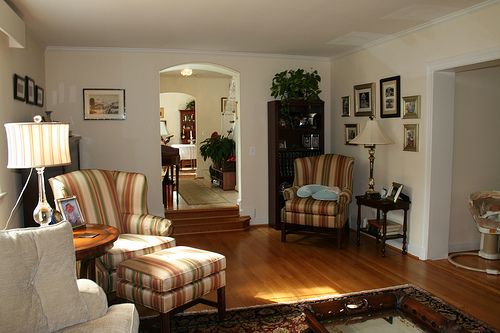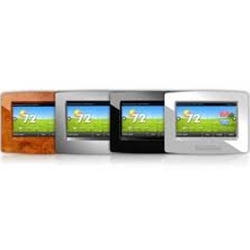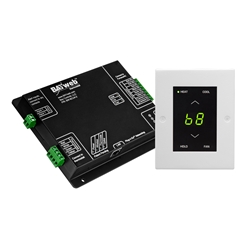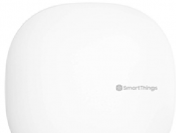With so many models of programmable thermostats to choose from, it’s easy to be swayed by all of the advanced technology and fancy features that are out there today. To find a programmable thermostat that really delivers on its promises of convenience and energy savings, you have to choose one that passes the compatibility test with your current HVAC equipment and the layout of your home. Choosing the wrong thermostat can damage your equipment, so take the time to go through this checklist to help you select a programmable thermostat that will work properly in your home.
Compatibility with Your Equipment
The first step in choosing a programmable thermostat is to make sure it is compatible with your HVAC system. Here are four criteria you will want to investigate:
1) Type of heating and cooling system
Check to see if you have a heat pump, boiler, furnace or electric baseboard and pick a programmable thermostat that the manufacturer says will work with your system.
– TIP: Some modern heating and cooling systems, like heat pumps, require specially-designed programmable thermostats. That’s because when a heat pump is in heating mode, setting back the temperature using a conventional heat pump thermostat can cause the unit to operate inefficiently, thereby canceling out any savings achieved by lowering the temperature setting.
 2) Number of heating and cooling stages
2) Number of heating and cooling stages
Determine how many stages you have by looking inside the old thermostat. If you have more than one stage of cooling, there may be y1 and y2 terminals with wires on them. If you have a two-stage furnace, there may be w1 and w2 terminals with wires on them.
–TIP: Some programmable thermostats, like the new learning types, may ONLY be compatible with one-stage cooling and one- or two-stage heating. Â If you have two or more stage heating and cooling, you may need an advanced multi-stage thermostat like the Venstar ColorTouch. This thermostat is compatible with most heating and air conditioning equipment, including heat pumps, with up to four heating and two cooling stages.
3) Voltage
The voltage and wiring of your new programmable thermostat and that of your heating and cooling system must be compatible. Most modern HVAC systems are low voltage (24V), so the majority of thermostats also operate on 24V. However, baseboard heaters and many totally electric heaters require a line voltage thermostat that operates on the same voltage as the heater (usually 120V or 240V).
–TIP: You can check the voltage of your thermostat with a voltmeter at the thermostat base by pulling the thermostat off of the base and checking between the R and C terminals on the base. These are probably red and black wires, but color codes are not always followed and are not completely standardized. If you are uncomfortable doing this yourself, use a qualified service technician to evaluate your system.
4) Wiring
You will also need to determine how your existing thermostat is wired to your heating or cooling system. Begin by turning off the power supply to your furnace or A/C. Remove the cover of your existing thermostat and examine the terminals and wires. Make a list of each wire by color and the letter used to identify the terminal it’s connected to. Compare this list to the wiring diagram of the new thermostat you’ve chosen and make sure that it has at least the same number of terminals as the old one.
– TIP: Before buying, check the wiring diagram for the new programmable thermostat to make sure it’s compatible. Diagrams can be found in the owner’s manual, which is usually posted on the website of the manufacturer or distributor.
– TIP: Most programmable thermostats have a clock that uses power from either the system’s low-voltage control circuit or from a rechargeable battery. If yours is battery-powered, make sure your HVAC system has a common C wire to charge the battery when the system is not running. Otherwise the thermostat may turn the system on and off to get power to charge the battery as some learning thermostats do, which can cause your equipment to wear out prematurely.
Compatibility with Your Home
A programmable thermostat must fit the layout of your home in order to work properly. Considerations include where the thermostats are located and the number of heating and cooling zones you have.
The location of a thermostat can drastically affect its performance and efficiency. Ideally, thermostats should be located where they are convenient for you to access and away from things like direct sunlight or drafts that will affect how the thermostat performs.
Thermostat location can be a real problem for learning thermostats which use a built-in occupancy sensor to measure the family’s activity to create a customized temperature schedule. If the learning thermostat is in an isolated place like a living room, instead of in a high-traffic location, the auto-program it creates will be inaccurate and ineffective and do things like turn off the heating or A/C when the house is occupied.
– TIP: A good alternative to a learning thermostat is a programmable thermostat that uses wireless motion/occupancy sensors that can be placed in strategic high-traffic places around the house. The remote sensors will sense movement when people are home and communicate that to the thermostat, which will adjust temperature accordingly.
2) Number of Zones
Many homes have multiple heating/cooling zones so you can control temperature in different sections of the house independently and heat or cool the only the rooms you are using. Remember that each zone has its own thermostat, so if want to be able to program temperature in each zone, you’ll need multiple programmable thermostats.
–TIP: Some advanced programmable thermostats, like those made by BAYWeb, allow you to control multiple zones from the thermostat you designate as master so you don’t have spend time programming or changing individual thermostats.
Summary
 A programmable thermostat can help reduce your energy bill by heating and cooling your house only when you really need to. Make sure you choose a model that works with your current HVAC system and fits the layout of your house. Before making your final selection, you should also consider your lifestyle and habits. Read more about ensuring lifestyle compatibility in Part 3 of this series on programmable thermostats.
Sources:






Ronnie anderson
I have a cabin in the mountains. What I have available is a 1500 w electric portable heater. The day before arriving, I would like to call my cabin and have the heater come on to help take the chill off. I have a Franklin propane heater that keeps the cabin warm after I get there. I also have internet. What do you suggest?